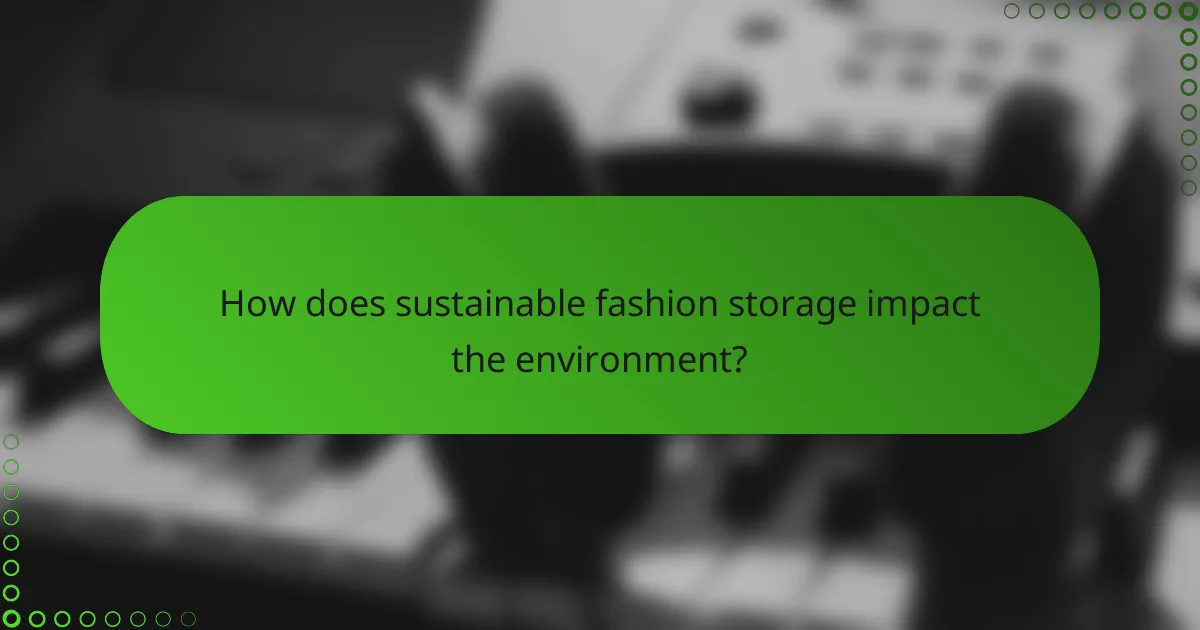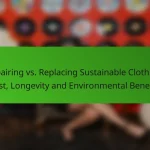Storing sustainable fashion requires careful consideration of methods that protect garment integrity while reducing environmental impact. By implementing best practices, you can extend the life of your clothing, minimize waste, and maintain quality, ultimately contributing to a more sustainable future.

What are the best practices for storing sustainable fashion?
To effectively store sustainable fashion, prioritize methods that protect the integrity of the materials while minimizing environmental impact. Implementing best practices ensures longevity and maintains the quality of your garments.
Use breathable garment bags
Breathable garment bags are essential for storing sustainable fashion items, as they allow air circulation while protecting against dust and moisture. Opt for bags made from natural fibers like cotton or linen, which are better for the environment compared to plastic alternatives.
Avoid using non-breathable plastic covers, as they can trap moisture and lead to mold growth. Instead, choose bags that fit your garments well to prevent creasing and maintain their shape.
Maintain optimal humidity levels
Keeping humidity levels between 40% and 60% is crucial for preserving sustainable fashion. High humidity can cause mold and mildew, while low humidity may lead to fabric brittleness.
Using a hygrometer can help monitor humidity levels in your storage area. Consider using a dehumidifier or humidifier as needed to maintain the ideal environment for your garments.
Store in a dark, cool environment
Light and heat can degrade fabrics over time, so it’s best to store sustainable fashion in a dark, cool place. Aim for temperatures around 15-20°C (59-68°F) to prevent damage from heat exposure.
Basements or closets away from direct sunlight are ideal storage locations. If using a wardrobe, ensure it is well-ventilated and not overcrowded to allow air circulation.
Organize by fabric type
Organizing garments by fabric type helps prevent damage and makes it easier to find what you need. Group similar materials together, such as cotton, wool, and synthetics, to ensure appropriate care for each type.
Consider using acid-free tissue paper to separate delicate items, which can help prevent snagging and creasing. Labeling storage bins can also aid in quick identification and retrieval.
Regularly inspect for pests
Regular inspections for pests are vital in maintaining the quality of your sustainable fashion collection. Look for signs of moths, silverfish, or other insects that can damage fabrics.
Consider using natural repellents like cedar blocks or lavender sachets to deter pests without harmful chemicals. Schedule inspections every few months to catch any issues early and take necessary action.

How does sustainable fashion storage impact the environment?
Storing sustainable fashion properly significantly reduces environmental impact by extending the life of garments and minimizing waste. Effective storage practices help maintain the quality of clothing, which in turn lessens the need for new production and its associated resource consumption.
Reduces waste through preservation
Preserving garments through proper storage techniques can significantly reduce textile waste. By keeping clothes in good condition, consumers can avoid discarding items that may still have useful life, thus contributing to a decrease in landfill contributions.
For example, using breathable garment bags instead of plastic can prevent mold and deterioration. Regularly cleaning and storing items in a cool, dry place can further enhance their longevity.
Minimizes carbon footprint
Effective storage of sustainable fashion can help minimize the carbon footprint associated with clothing production. By extending the lifespan of garments, the need for new manufacturing—which often involves high energy use and emissions—is reduced.
Consider that producing a single cotton t-shirt can require significant water and energy. By maintaining existing clothing, consumers can lower their overall demand for new items, thereby decreasing the carbon emissions linked to production and transportation.
Encourages circular fashion practices
Proper storage supports circular fashion practices by facilitating the reuse and recycling of garments. When clothes are well-preserved, they can be easily resold, donated, or repurposed, contributing to a more sustainable fashion ecosystem.
Engaging in practices like swapping clothes with friends or participating in local clothing exchanges can further promote circularity. This not only reduces waste but also fosters community engagement and awareness around sustainable fashion.

What materials are best for sustainable fashion storage?
For sustainable fashion storage, materials that minimize environmental impact while providing adequate protection for garments are essential. Options like organic cotton, bamboo, and recycled plastics are ideal as they are eco-friendly and effective in preserving clothing quality.
Organic cotton storage bags
Organic cotton storage bags are an excellent choice for storing sustainable fashion items. They are breathable, which helps prevent moisture buildup and mold, while being free from harmful chemicals used in conventional cotton production.
When using organic cotton bags, ensure they are clean and dry before storing garments. Avoid overstuffing the bags to maintain shape and prevent creasing. These bags are particularly suitable for delicate fabrics like silk and wool.
Bamboo shelving units
Bamboo shelving units provide a sturdy and sustainable option for organizing clothing. Bamboo is a fast-growing plant that requires minimal resources, making it an environmentally friendly choice for furniture.
When selecting bamboo shelving, look for units that are treated with non-toxic finishes to maintain their eco-friendliness. Ensure proper spacing between shelves to allow for air circulation, which helps keep stored garments fresh and reduces the risk of musty odors.
Recycled plastic containers
Recycled plastic containers are practical for storing sustainable fashion items, offering durability and resistance to moisture. These containers come in various sizes, making them versatile for different types of clothing and accessories.
Choose containers with airtight seals to protect against dust and pests. When using recycled plastic, check for recycling symbols to ensure they are made from post-consumer materials. Avoid exposing containers to direct sunlight, as this can degrade the plastic over time.

What are the common mistakes in storing sustainable fashion?
Common mistakes in storing sustainable fashion include using inappropriate materials, neglecting temperature control, and overcrowding storage spaces. These errors can lead to damage, reduced lifespan, and increased environmental impact of garments.
Using non-breathable materials
Storing sustainable fashion in non-breathable materials, such as plastic bags or containers, can trap moisture and promote mold growth. Instead, opt for breathable fabrics like cotton or linen for storage, which allow air circulation and help maintain the integrity of the garments.
Consider using garment bags made from natural fibers or acid-free tissue paper to protect delicate items while ensuring they can breathe. Avoid plastic wrap or sealed containers that can create a humid environment.
Ignoring temperature fluctuations
Temperature fluctuations can adversely affect sustainable fashion, particularly natural fibers like wool and cotton. Ideally, garments should be stored in a cool, dry place with a consistent temperature, avoiding areas like attics or basements where conditions can vary widely.
To maintain optimal conditions, aim for a storage temperature between 15-20°C (59-68°F). Using a hygrometer can help monitor humidity levels, keeping them ideally between 30-50% to prevent damage.
Overcrowding storage spaces
Overcrowding storage spaces can lead to creasing, stretching, or crushing of garments, which is particularly detrimental for sustainable fashion items. Ensure that clothes have enough space to hang or lie flat without being compressed.
When organizing your storage, consider using padded hangers for delicate items and folding heavier garments to prevent distortion. A good rule of thumb is to leave at least a few centimeters of space between each item to allow for airflow and easy access.

What criteria should be considered for sustainable fashion storage solutions?
When selecting sustainable fashion storage solutions, consider material sustainability, space efficiency, and cost-effectiveness. These criteria ensure that your storage methods align with eco-friendly practices while being practical and affordable.
Material sustainability
Material sustainability focuses on using eco-friendly and recyclable materials for storage solutions. Opt for storage boxes made from recycled cardboard or biodegradable plastics to minimize environmental impact.
Additionally, consider the longevity of the materials. Durable options reduce the need for frequent replacements, which contributes to waste reduction. Look for certifications like FSC (Forest Stewardship Council) for wood-based products to ensure responsible sourcing.
Space efficiency
Space efficiency is crucial for maximizing storage without overcrowding. Utilize vertical space with shelving units or hanging organizers to keep items accessible yet neatly stored.
Consider modular storage solutions that can be adjusted or expanded based on your needs. This flexibility allows for better organization and can accommodate seasonal changes in your fashion inventory.
Cost-effectiveness
Cost-effectiveness involves balancing quality and price when choosing storage solutions. While sustainable materials may have a higher upfront cost, they often save money in the long run due to their durability.
Evaluate your budget and prioritize investments in storage that offer the best value over time. Look for sales or bulk purchasing options to reduce costs while maintaining sustainability standards.










